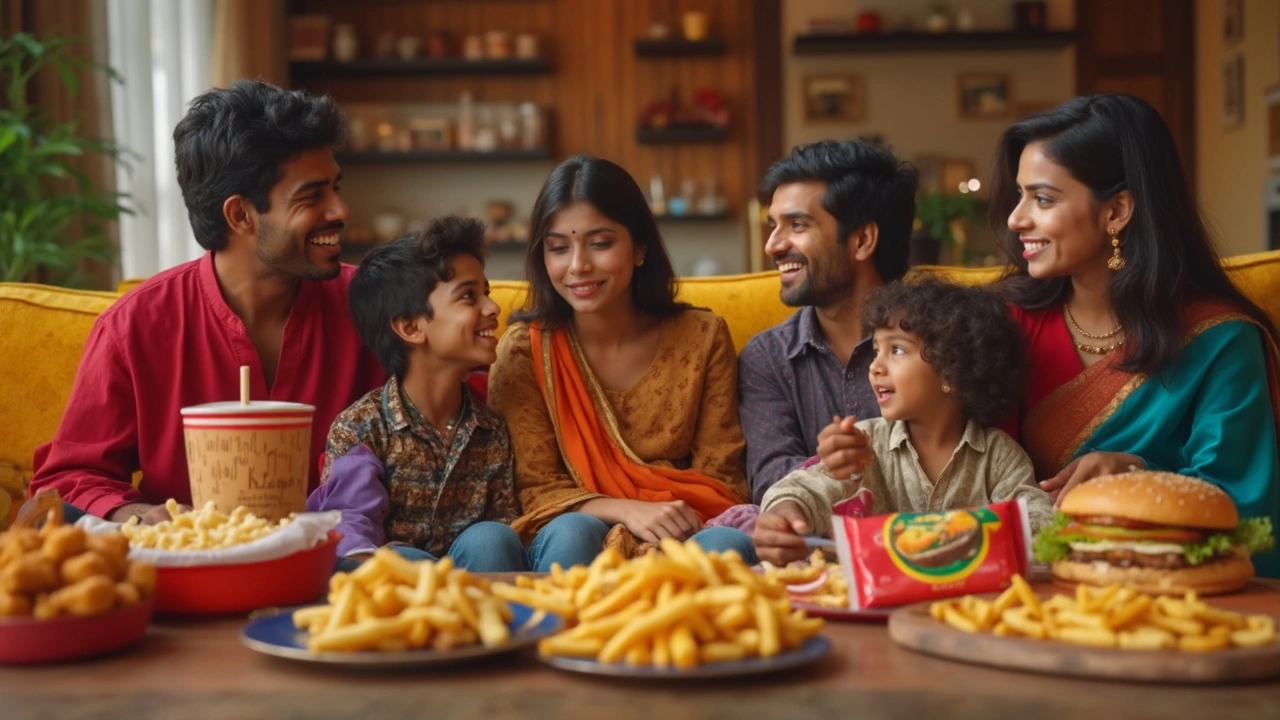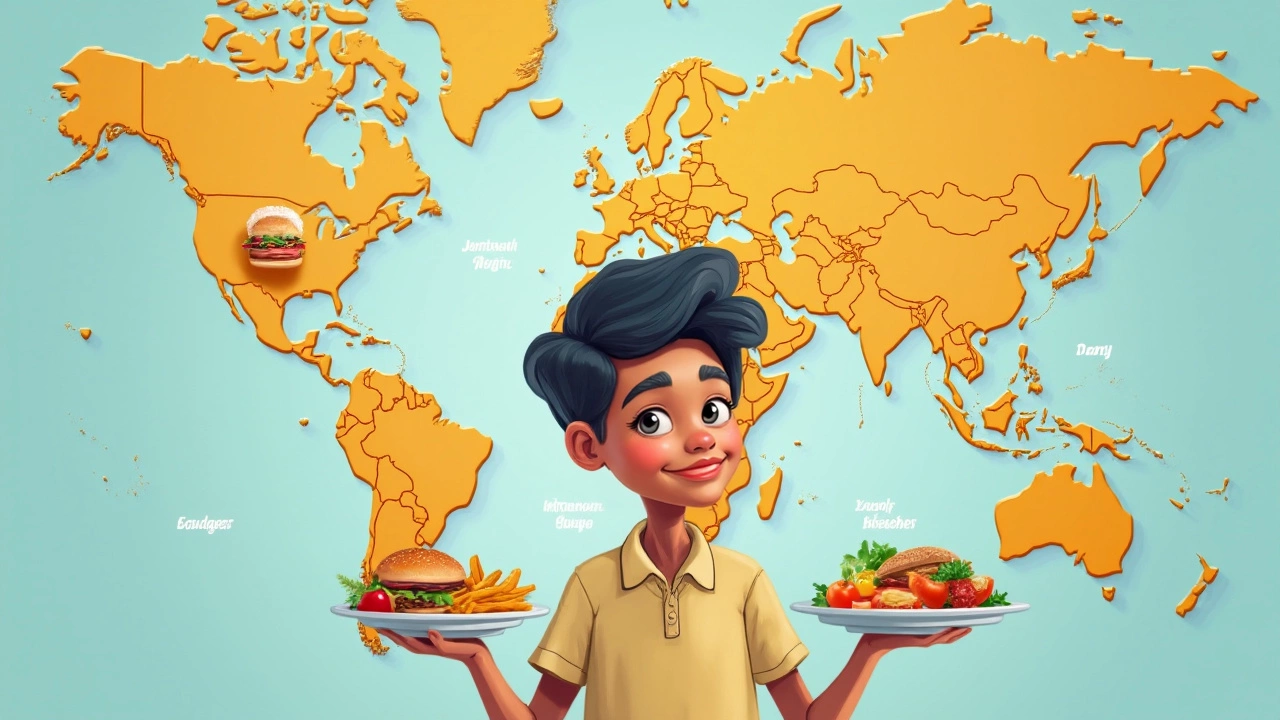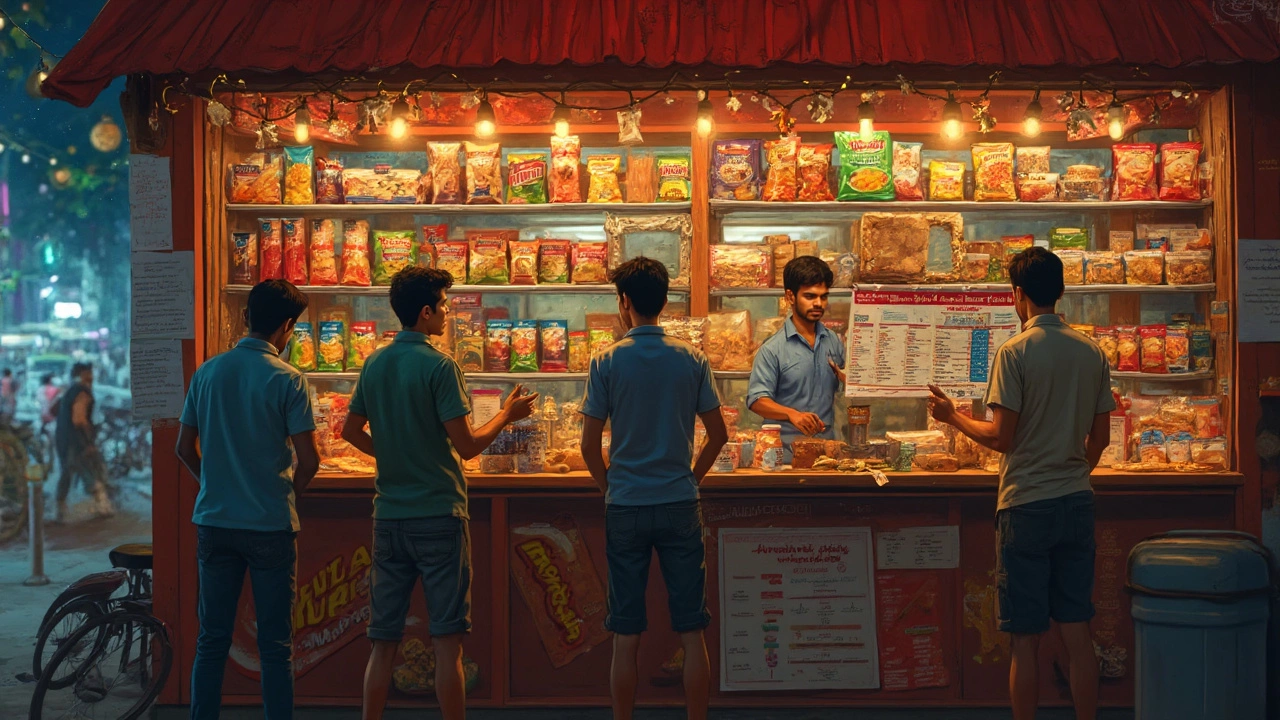Which Country Eats the Most Unhealthy Food? Surprising Facts for Snack Lovers
 Apr, 29 2025
Apr, 29 2025
Think your snack choices aren't a big deal? The country you live in might have more to do with it than you realize. Some nations have such a crazy love for fried, sugary, and processed foods that the results are showing up in health charts. Americans, for example, are legendary for supersized meals, cheesy pizzas, and those never-ending bags of chips. Year after year, studies find the United States takes the crown for eating the most unhealthy food overall. The stats are wild—like, over 63% of American calories come from ultra-processed grub.
It’s not just about fast food chains on every corner. Supermarkets are packed with sweet treats, frozen dinners, and sodas you can buy by the liter. Kids grow up on chicken nuggets and tater tots, while adults may swap home-cooked meals for instant noodles, pizza, or packaged snacks. The impact? Waistlines keep growing, and so do rates of diabetes and heart disease.
- Who Tops the List for Unhealthy Eating?
- What Makes a Country’s Food Unhealthy?
- How India Fits into the Snack Scene
- Switching to Smarter Snacks: Practical Tips
- Healthy Indian Snack Ideas for Busy Lives
Who Tops the List for Unhealthy Eating?
If you’ve ever wondered who really leads the world when it comes to eating the most unhealthy food, the numbers paint a pretty stark picture. The United States is always up there, thanks to its obsession with fast food, extra-large sodas, and loads of ultra-processed snacks. According to a 2023 Global Nutrition Report, more than 60% of American daily calories come straight from packaged foods or fast food. That’s more than most countries by a long shot.
But the US isn’t alone. The UK and Australia also see people packing their carts with processed meats, sugary drinks, and salty nibbles. Western Europe tags along, especially places like Germany and France, where processed sausage rolls and cream-loaded bakery treats are super popular. What’s driving all this? Convenience, busy work routines, and how cheap fast food can be compared to fresh fruits or veggies.
| Country | Processed Food Share (%) | Obesity Rate (%) |
|---|---|---|
| USA | 63 | 36 |
| UK | 53 | 28 |
| Australia | 52 | 30 |
High numbers like these explain why these countries have the world’s highest obesity and diabetes rates. For comparison, India’s rate of processed food intake is still far lower, but that’s changing fast with the explosion of instant noodles, wafers, and soda in cities.
It’s not just about the food itself—how much you eat and how often you grab a snack matters. In these countries where unhealthy eating is basically baked into the culture, it’s normal to eat several portions of junk food every day. That’s a habit India is just starting to pick up, but we’re not leading the charts—yet.
What Makes a Country’s Food Unhealthy?
Ever wondered why some countries have a bad rep for what ends up on their plates? It’s usually down to a few big things: how much unhealthy food people eat, the way it’s made, and what’s actually in it. A lot of it comes down to how processed the meals are—meaning how far the food is from its natural state. The more it gets chopped, fried, frozen, or loaded with extra stuff like sugar, salt, and oil, the less healthy it gets.
Most of the time, you’ll see unhealthy eating patterns in places where fast food, packaged snacks, and sugary drinks are everywhere. For example, the U.S. and the UK have streets lined with burger joints, and even supermarkets are packed with salty chips and creamy desserts. People get used to grabbing these quick fixes during busy days, so home-cooked meals take a back seat.
Here’s what usually makes a country’s food diet slide into the "unhealthy" zone:
- Big portions of fried and oily foods
- Easy access to processed snacks and sugary drinks
- High sugar, salt, and trans fat levels in ready-to-eat meals
- Low fruit, veggie, and whole grain intake
- Heavy reliance on takeaways or street food over homemade meals
Let’s look at some concrete data to see how this plays out globally:
| Country | % Calories from Ultra-Processed Foods |
|---|---|
| United States | 63% |
| United Kingdom | 57% |
| Canada | 48% |
| India | ~10% |
The numbers don’t lie—countries leading in processed food calories also face sky-high rates of obesity, type 2 diabetes, and heart problems. It’s no accident. When most of the daily energy comes from unhealthy snacks and fast food, the body feels it sooner or later.

How India Fits into the Snack Scene
In India, snacking is a national pastime. You can barely make it through a train ride or an office break without someone offering samosas, pakoras, or biscuits. It’s not just about taste—these snacks are tied to family, traditions, and celebrations. But let’s be real: many popular Indian treats are deep-fried, sugar-packed, or loaded with salt, putting them right up there with the world’s unhealthy food favorites.
If you peek into any grocery basket, you’ll spot a mix of traditional munchies (like namkeen or mathri) and modern options, like potato chips, cookies, and chocolates. The snack industry here is booming. According to a Nielsen survey, urban Indian homes spend about a fourth of their annual food budget on snacks. That’s huge!
The numbers back this up. Check out this quick comparison on snacking habits around the world:
| Country | Fast Food Meals Per Week (Average) | % Calories from Processed Snacks |
|---|---|---|
| United States | 3.1 | 63% |
| India | 1.6 | 25% |
| UK | 2.4 | 51% |
Now, while India doesn’t top the global list for unhealthy food intake, we’re definitely catching up. Urban lifestyles mean more people grab ready-to-eat snacks and soft drinks on the go. Take it from a dad like me: when my kids, Anaya and Rishi, want something quick, resisting packaged junk food can be a real challenge. The big difference? Our market is still a mix—there’s junk, but also plenty of homemade and healthier traditional choices.
So, India sits at a crossroads. We love our snacks, but there’s a growing push for healthy Indian snacks. With a little effort, it’s totally possible to swap out the greasy stuff for lighter, more nutritious bites—without giving up the flavors we crave.
Switching to Smarter Snacks: Practical Tips
If you catch yourself reaching for chips or cookies whenever your stomach growls, you’re not alone. The key is not to stop snacking, but to swap out those junky picks for smarter ones. Here’s how you can make that change without feeling like you’re missing out.
- Check the label: Look for fewer ingredients. If your snack has a long list of things you can’t pronounce, it’s likely an ultra-processed food. Go for snacks with whole, real ingredients.
- Mind the portion size: Even healthy stuff can add up if you eat too much. Use small bowls or plates to avoid mindless munching.
- Keep healthy snacks handy: Stock up on roasted chana, fox nuts (makhana), fruit slices, or homemade popcorn. If healthy snacks are easy to grab, you’re less likely to reach for unhealthy food.
- Upgrade your cravings: Love sweet stuff? Try dates with a dab of peanut butter. Craving salty? Air-popped popcorn sprinkled with spices or baked khakra can hit the spot without the guilt.
- Stay hydrated: Sometimes you feel hungry when you’re actually just thirsty. Drink water, or try coconut water for a change.
Here’s the kicker: according to a 2023 survey from the Indian Council of Medical Research, 83% of urban Indians snack at least once a day, and over half admit they don’t look at nutrition labels. Swapping just one daily junk snack with a healthier choice can lower your risk for problems like diabetes and high cholesterol.
| Snack Choice | Calories (per 30g) | Added Sugar | Fiber |
|---|---|---|---|
| Potato Chips | 160 | 2g | 1g |
| Roasted Chana | 120 | 0g | 4g |
| Chikki (Peanut Brittle) | 135 | 6g | 2g |
| Apple Slices | 60 | 0g | 2g |
If you’re serious about cutting down on unhealthy food, remember: tiny changes go a long way. Mix up your stash, try homemade versions of your favorites, and don’t fall for marketing tricks like "low-fat" or "sugar-free." Real food always wins in the end.

Healthy Indian Snack Ideas for Busy Lives
Busy schedules don’t mean you have to reach for those oily chips or cookies. There are tons of healthy Indian snacks that you can pack, prep, or even just grab from your kitchen without feeling guilty. And honestly, they taste way better than most unhealthy food from the store.
One go-to option is roasted chana (chickpeas). They’re loaded with protein and fiber, making you full for hours. You can also try makhana (fox nuts) roasted with a pinch of salt and pepper. It’s light, crunchy, and great for kids like Anaya and Rishi.
If you like something on the run, grab a homemade moong dal chilla roll stuffed with grated veggies. Takes less than 15 minutes and can be eaten cold or hot. If you’re into DIY snacks, boiled corn with chaat masala or simple bhel made with puffed rice, tomatoes, onions, and coriander does the trick without wrecking your health.
"Snacks don’t have to be junk. A handful of nuts or homemade dhokla can make all the difference." – Dr. Rujuta Diwekar, celebrity nutritionist
Let me break down some options you can rotate through the week. Trust me, these aren’t just for kids—grown-ups love them too:
- Roasted peanuts or mixed nuts (easy to carry in a box, healthy fat and protein)
- Homemade upma (make a big batch in the morning—have leftovers as a snack)
- Steamed sprouts salad (mung beans, black chickpeas, onions, dash of lemon)
- Dhokla or idlis (soft, easy to pack, low in oil)
- Fruit chaats (mix any seasonal fruits with rock salt and black pepper)
Need numbers? Here’s a quick look at how these Indian snacks compare to the average packaged snack food on supermarket shelves:
| Snack | Average Calories (per serving) | Protein (g) | Fiber (g) |
|---|---|---|---|
| Roasted Chana | 120 | 7 | 6 |
| Makhana (Fox Nuts) | 90 | 3 | 2 |
| Packed Potato Chips | 150 | 2 | 1 |
See the difference? Home-grown options offer more nutrition and less junk. Next time you’re hungry at 4 pm or packing a tiffin for your kids, swap the ready-made stuff for one of these easy Indian ideas. Your body—and your energy levels—will thank you.